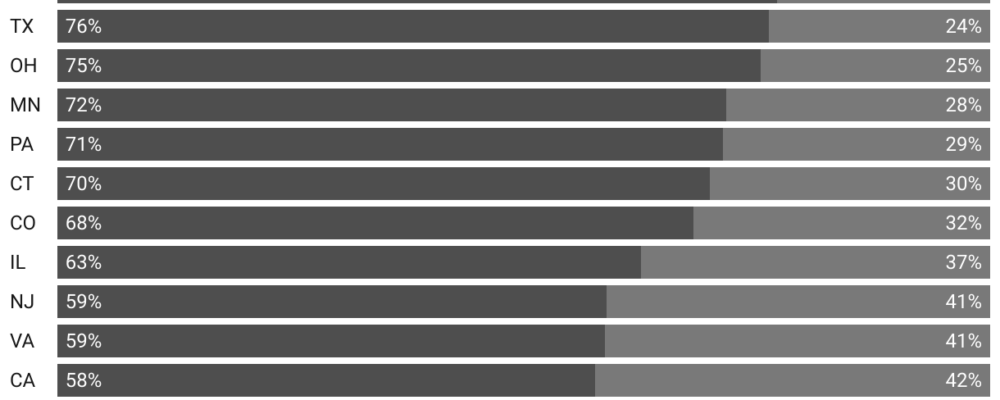When Katherine Coffman presents her research findings about how gender stereotypes shape the behavior of men and women in the workplace, she is often asked: What about non-binary individuals?
“People understandably keep asking, ‘What about people other than men and women?’ We know a lot of past [research] hasn’t included everyone,” says Coffman, the Piramal Associate Professor of Business Administration at Harvard Business School.
A 2021 Williams Institute study found that about 1.2 million people in the US identify as non-binary—that is, they don’t identify exclusively as either men or women, but rather, may identify as a mix of both genders, consider themselves somewhere in between, or decline to align with either gender. Coffman set out to understand this population better—in terms of how others perceive them and how they perceive themselves, including their economic preferences and their life and career aspirations.
Coffman presents her findings in a new working paper that explores the experiences, goals, and preferences of non-binary people
and how these compare with those of men and women. Past research provides important insights into how gender differences in beliefs and preferences contribute to disparities in the workplace. Ultimately, this study aims to extend this line of research to include non-binary individuals, revealing how their beliefs and preferences compare and providing insights for managers seeking to support and advance this group.
Coffman’s paper is based on a large online survey and was cowritten with Boston College Professor Lucas Coffman and Boston University Professor Keith Marzilli Ericson.
Understanding the aspirations of non-binary people
Relatively little research has been conducted about non-binary people in the workplace, Coffman says. In fact, many traditional surveys often don’t reach enough respondents who identify as non-binary to create a meaningful sample.
The research team used the platform Prolific, which specifically allowed them to recruit participants according to gender identity. The team surveyed more than 450 non-binary respondents, in addition to more than 700 men and more than 700 women. The sample, Coffman notes, includes people across the US of different ages, races, and income levels.
“People may have different motivators in terms of what drives them at work and what allows them to thrive.”
The researchers asked survey respondents a wide range of questions related to their beliefs and preferences. They found that overall, non-binary individuals:
- Underestimated their own performance more than women, who also underestimate their talents to a lesser degree. And non-binary people underestimate themselves much more than men, who tend to overestimate their performance.
- Showed more impatience than men and women, but their risk tolerance fell somewhere between men and women.
- Preferred solitary work. They were less likely to want to work with other people than men and women.
- Were less motivated by money and are more likely to want to help their community than men and women. They were also less likely to want children than men and women.
- Expressed lower degrees of assertiveness than men or women across a range of attributes—including competitiveness and willingness to negotiate. They were also more likely to report being willing to take on non-promotable tasks—those activities that support the organization but are typically not rewarded. While more research is needed, Coffman speculates that differences in status and power may contribute to these gaps, similar to how these forces contribute to differences between men and women.
Managers should be aware of these differences in behaviors, perspectives, and goals, rather than assuming everyone navigates the workplace in the same way or wants the same thing out of their career, Coffman says. “People may have different motivators in terms of what drives them at work and what allows them to thrive,” she says. “Tapping into what makes people tick and keeps them engaged is just smart practice.”
How others perceive non-binary people
In terms of how others perceive non-binary people, the results showed:
- Non-binary people and women report a similar level of discrimination in the workplace. Non-binary respondents said they experienced discrimination an average level of 1 on a 3-point scale, the same as women, with 0 being “never” and 3 being “frequently.” Men reported experiencing less discrimination than both groups, with a rating of 0.5. Meanwhile, non-binary people reported higher levels of discrimination than both men and women in other realms, such as at school, online, in the legal and judicial systems, and in public.
- Women and men report mixed levels of comfort with non-binary individuals. The researchers found many people agree with the existence of non-binary gender identity—with the most common response, “strong agreement,” at 30 percent. The second-most frequent response, however, was “strong disagreement,” at 15 percent, representing a large number of people who don’t seem to acknowledge that non-binary identity exists.
- Women generally perceive non-binary people more favorably than men. Women expressed less discomfort with non-binary people and were more likely to believe the non-binary identity existed than men.
“There’s clear polarization in the data, with many people reporting complete acceptance of and comfort around non-binary individuals, but another substantial group who reports the opposite,” Coffman says.
“Most of us have a friend or family member who is gay, but maybe not everyone is at the point where they know someone who is non-binary.”
In fact, the level of discomfort with non-binary individuals among some people exceeds their discomfort with LGBTQ individuals—which may be a product of people’s lack of familiarity and exposure, she says. “Most of us have a friend or family member who is gay, but maybe not everyone is at the point where they know someone who is non-binary,” Coffman says. “These personal relationships may be important for increasing inclusion and reducing discrimination.”
How to create a more inclusive workplace
Managers can take steps to help all individuals, regardless of gender, feel accepted at work by:
- Recognizing pronouns to show respect. Managers should not assume that everyone on their team identifies as a man or woman; sharing preferred pronouns can be a small step toward inclusiveness. Most non-binary respondents in the survey used “they/them.” Managers and their teams should make a deliberate effort to use the correct pronouns and be willing to correct each other when mistakes are made, Coffman says.
- Acknowledging that non-binary people may shy away from competitive positions. Managers may need to make a more concerted effort to recruit non-binary individuals or encourage them to apply for promotions, given that many underestimate their performance and are less assertive. “Sometimes we have the notion that the best candidates rise to the top and are going to throw their hands up and self-advocate, but that’s not always the case,” Coffman says.
- Avoiding behaviors that reinforce traditional gender power dynamics. Coffman says certain strategies that people have begun to be aware of that increase inclusion for women—such as being conscious of not interrupting and refraining from disproportionately delegating support tasks to them—could also help non-binary coworkers feel valued and included.
Awareness of differences among genders can be helpful, but Coffman adds that it’s also important to understand the many similarities across individuals. One clear trend in the survey data was that men, women, and non-binary people all tended to overestimate differences in behaviors across gender.
In other words, Coffman says, people should be aware that everyone is an individual first—and we may not be as different from others as we think.
“There are a lot of misperceptions out there,” she says, “and stereotypes that reduce individuals to their gender identity are likely to lead to missed opportunities in the workplace and beyond.”
You Might Also Like:
Feedback or ideas to share? Email the Working Knowledge team at hbswk@hbs.edu.
Image: Illustration created by HBSWK using an image from AdobeStock/hanahal
“Harvard Business School is the graduate business school of Harvard University, a private research university in Boston, Massachusetts. It is consistently ranked among the top business schools in the world and offers a large full-time MBA program, management-related doctoral programs, and executive education programs.”
Please visit the firm link to site






